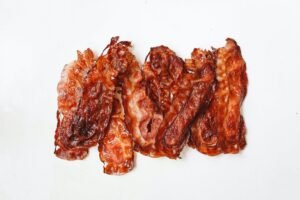The Delicious History of a Full Irish Breakfast, Deconstructed

If you’ve visited and/or lived in Ireland, then you must know that the full Irish breakfast, or a fry-up, is a glory to behold. The Irish are known for their hearty sit-down meals, and the fry-up is no exception.
The traditional full Irish came to be as a variant of the full English breakfast: gentry in fourteenth-century England introduced the platter, since it was a socially accepted idea in country houses to create large, lavish meals for the important people who were often hosted. But, by the time of the Industrial Revolution, the full English became a widespread dish more indulged by labour workers. And, lo and behold, the full English became broader in its undertaking, reaching Ireland not long after.
The Irish created the fry-up as a way to prepare for farmers’ heavy-duty workdays on cold, winter mornings; the meal was prepared with local produce and homemade items, all of which were combined together and “fried up” on the pan with a pad of Irish butter.
Nowadays, the fry-up is usually no longer eaten during the weekday mornings, but rather reserved for a lazy Sunday. The full Irish is made differently depending on the household, region, etc., so the items mentioned down below might diverge from your own take. However, these items listed are considered to be the general traditional staples of a fry-up, so do what you will with this information!
- Food and Culture: How Are They Related?
- Irish Food Combinations That’ll Make Your Jaw Drop
- Potatoes, What’s Else?
 Bacon
Bacon
Rashers is Irish slang for bacon. No fry-up is complete without rashers. Rashers come in different types, such as back (wide) or streaky (narrow). The common amount of rashers in a full Irish is two!
Pork Sausages
Irish sausages translate to pork sausages. Chicken or beef sausages are a rarity in Ireland, so don’t try to convince the cook otherwise. But, I promise, pork sausages are a glorious must-have. They’re usually 80% pork meat; the other 20% is a combination of blended spices that will want you asking the preparer for directions to their butcher.

Eggs
Usually, eggs are fried, but it’s completely up to your preference. You can decide if they’re scrambled, poached, hard-boiled, soft-boiled, etc. But, if you want an extremely traditional meal, I’m afraid fried eggs are the standard.
Baked Beans
Baked beans need no explanation or introduction – just a little sizzle on the pan!
Black Pudding
Black pudding, simply put, is blood pudding. Yes, it is made from blood. The cook prepares black pudding by adding blood to pork fat or beef suet, followed up with a mix of barley and oatmeal groats. To be honest, I tend to skip the black pudding, but I’ve been assured that it’s a rite of passage!
White Pudding
As for white pudding, it’s similar to black pudding, but get this: there’s no blood included. So, if eating blood pudding isn’t your thing either, this might be the perfect stepping stone for you to stay true to the Irish way.
Toast
Hear me out: toast is more of the utensil rather than the accompaniment. Use it as a spoon or as a makeshift wipe for your dish. But, before you do any of that, appreciate its beauty. Watch as the creamy Irish butter drips off of it in rivulets. But, toast isn’t always the go-to. Depending on where you are in Ireland, the bread varies greatly. In the North, fadge – or potato bread – is a better complement to their fry-up. It is prepared with mashed boiled potatoes and a bit of little white flour; it is then baked in farls on a griddle.
Fried Tomato
Tomato isn’t in my diet, but I’ve heard no full Irish breakfast is a full Irish breakfast without them fried on your dish.
Now, just don’t forget to set the kettle for your Barry’s tea to go along with your full Irish!
Resources: